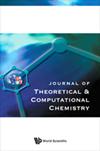Activity Trends in Desoxy Anthrapyrazoles: The Influence of Molar Volume, Polarizability and Lipophilicity of N2 C5 Side Chains on Their Anticancer Response
IF 2.4
Q3 Computer Science
引用次数: 0
Abstract
QSAR methodology was used to assess the effects of lipophilicity (logP), molar volume (MV) and polarizability (pl) of the side chains at N2 and C5 of 20 known desoxy anthrapyrazoles on their in vitro anticancer activity expressed as the negative logarithm of the inhibitory concentration of 50% of L1210 murine leukemia cell line (1/logIC50). The main data set shows poor correlations between biological response and the descriptors with exception of MV of the C5 side chain, where a moderate correlation was discerned ( =0.60, n = 18, two outliers). To extract more information regarding mechanism, the main data set was visually classified to three clusters depending on N2 side chain. Cluster 1 containing six 5-substituted 2-[(2-hydroxyethyl) amino] ethyl anthrapyrazoles; cluster 2 contains ten 5-subsitutes 2-(diethyl amino) ethyl anthrapyrazoles and cluster 3 contains four anthrapyrazoles with miscellaneous substituents at both N2 and C5. For cluster 1, MV and pl of C5 show high correlation with biological response (R2’s = 0.75 and 0.72 respectively) while logP gives a weak correlation (R2 = 0.44). For cluster 2, the correlations of logP and pl of C2side chain are higher (=0.66 and 0.62 respectively) compared with MV (=0.16). Cluster 3 shows very poor correlation with all descriptors (~0.3). This indicates mechanistic distinction between the three clusters. Derived descriptors which represent the difference between the descriptors of N2 and C5 side chains where used to explore the presence of interplay between these descriptors in affecting variability of the biological response.脱氧蒽唑的活性趋势:N2 C5侧链的摩尔体积、极化性和亲脂性对其抗癌反应的影响
采用QSAR方法评价了20种已知的去氧基蒽唑的亲脂性(logP)、摩尔体积(MV)和极化率(pl)对其体外抗癌活性的影响,其体外抗癌活性表示为L1210小鼠白血病细胞株50%抑制浓度的负对数(1/logIC50)。主要数据集显示,除了C5侧链的MV外,生物反应与描述符之间的相关性较差,其中存在中等相关性(=0.60,n = 18,两个异常值)。为了提取更多的机理信息,我们根据N2侧链将主数据集视觉上划分为3个簇。含有6个5-取代的2-[(2-羟乙基)氨基]乙基蒽吡唑的簇1;簇2包含10个5-取代2-(二乙基氨基)乙基蒽唑,簇3包含4个在N2和C5上具有杂项取代基的蒽唑。在聚类1中,C5的MV和pl与生物反应呈高相关性(R2 = 0.75和0.72),而logP呈弱相关性(R2 = 0.44)。对于聚类2,c2侧链的logP和pl的相关性(分别为0.66和0.62)高于MV(=0.16)。聚类3与所有描述符的相关性都很差(~0.3)。这表明了三个集群之间的机制区别。衍生描述符表示N2和C5侧链描述符之间的差异,用于探索这些描述符之间在影响生物反应可变性方面的相互作用。
本文章由计算机程序翻译,如有差异,请以英文原文为准。
求助全文
约1分钟内获得全文
求助全文
来源期刊
CiteScore
1.70
自引率
0.00%
发文量
0
审稿时长
3 months
期刊介绍:
The Journal of Theoretical and Computational Chemistry (JTCC) is an international interdisciplinary journal aimed at providing comprehensive coverage on the latest developments and applications of research in the ever-expanding field of theoretical and computational chemistry.
JTCC publishes regular articles and reviews on new methodology, software, web server and database developments. The applications of existing theoretical and computational methods which produce significant new insights into important problems are also welcomed. Papers reporting joint computational and experimental investigations are encouraged. The journal will not consider manuscripts reporting straightforward calculations of the properties of molecules with existing software packages without addressing a significant scientific problem.
Areas covered by the journal include molecular dynamics, computer-aided molecular design, modeling effects of mutation on stability and dynamics of macromolecules, quantum mechanics, statistical mechanics and other related topics.

 求助内容:
求助内容: 应助结果提醒方式:
应助结果提醒方式:


